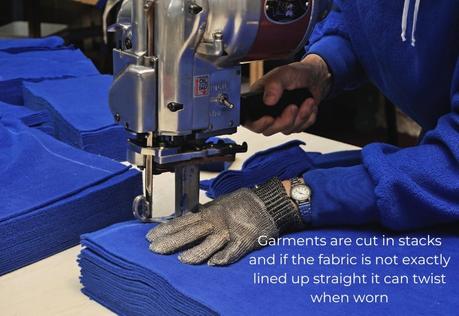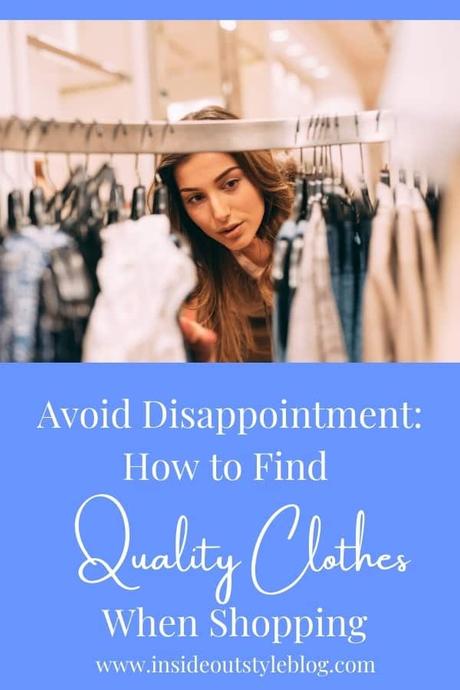



How do you know that the clothes you’re buying will wear well and are good quality? If you’re not a seamstress (where you’ve spent hours and hours of your life making clothes and learning about construction techniques and the qualities of different fabrics) it can be hard to know what you’re getting, and it’s easy to be disappointed. You wonder why that $30 t-shirt lasts yet the $200 one doesn’t. Here are some of the most common complaints about clothing and what to look for when shopping for clothes to have an increased chance of higher quality (and longer lasting) garments.
&iv;&modestbranding;&rel;&autohide;&playsinline;&autoplay;
Will it Crease?
Not everyone minds creasing, if you’re a linen lover, then wrinkles may not bother you at all. But if you prefer your clothes to stay smooth then you’ll want to make sure that you always do the Scrunch test for creasing before you bother taking a garment to the change room to try on.
How to Do the Scrunch Test
Grab a handful of fabric and scrunch it up for a second or two then let go. If it springs back with little or no creasing then this garment will stay smooth. If you’ve left a wrinkled patch on the garment then this will crease easily when wearing and you shouldn’t bother taking it into the change room if wrinkles bother you!
Will it Twist?
Sometimes you might get a garment that the seams twist around your body rather than staying straight. This is to do with poor manufacturing and it’s because when mass-market clothing is cut, they are cut by a machine and many garments are cut at the one time, so maybe the fabric isn’t lined up exactly straight, and that garment isn’t cut on the “straight of grain” and so will twist and pull on your body.

Will It Stretch Out of Shape?
Some garments such as jeans stretch out of shape quickly. This is related to how much elastane is in the fabric. You’ll normally have somewhere between 1-5% elastane and the rest of the denim is cotton. So a 5% elastane with 95% cotton mix will stretch out and bag out more easily and quickly than a 1% elastane with 99% cotton which will hold its shape (though it will be a little less comfortable. You may want a 2%/98% mix of elastane/cotton to have the comfort of the stretch without it losing its shape too quickly.
Price Doesn’t Always Equal Quality
Sadly, these days price doesn’t always equal quality in fabrics or construction. Often a higher price means better construction, but not always, sadly sometimes garments are higher priced because of the brand (and perception of that brand).
But sometimes it does, such as in a fabric like cashmere, a higher priced one is likely to be a better quality one. Your Uniqlo $99 cashmere is not as soft and won’t wear as well as a $1000 version which will be a higher quality as the fibres are longer (which means less pilling) but as it’s a more scarce resource, it costs more to produce.
How to Check the Quality of Fabrics such as Cashmere
That high-quality cashmere will feel thick and densely knitted rather than have little holes you can see through. When you stretch it it will bounce back, and how many ply? A one-ply cashmere will get holes more quickly than a two-ply cashmere. The more loosely knitted or woven a garment the more you’ll get snags and pulls and holes more quickly.
Another example is leather which can be cheap and stiff, or expensive and buttery soft.
How is it Constructed and Finished?
How a garment is sewn together can make a difference to how it wears and if it starts falling to pieces more quickly.
The length of the stitches in the seams can mean it falls to pieces faster when it’s a longer stitch, whereas a short stitch will hold together more firmly and you won’t get holes in the seams.
Look inside the garment how is the edge of the fabric finished? With knit garments (they stretch easily) they’ll generally be overclocked/serged, which looks like a loopy titchy along the edge of the seam.

With woven fabrics ideally, you want a better finish, such as a French seam, where you don’t see the edge of the fabric as it’s enclosed inside the seam, it’s more expensive to produce as you have to sew the seam twice, whilst anything overlocked/serged only needs one pass of the machine as the seam is stitched at the same time as the edge is serged. So a garment with a flat French seam will take twice as long to construct, so it should have a higher price tag!
Top Stitching
This is where you see a stitch on the outside of a garment (or a shoe), it should be smaller, even stitches, long stitches won’t wear as well, and the cotton should look thick and with some shine, if the cotton looks at all fluffy it won’t wear well as it will start fraying quickly.
Shoes can have their soles stitched to the upper, this is a sign of a more expensive shoe as most cheaper shoes the sole is glued to the upper (and the glue can start to degrade over time and you’ll get holes between the sole and the upper).
Laundering Requirements
Another thing to consider is what are the laundering requirements of any garment. If it’s Dry Clean Only, that adds a lot of additional cost to that garment (unless it’s a blazer or jacket that generally requires dry cleaning to retain shape because of the construction and fabrics, but you don’t have to launder after every wear, you only launder after many wears or when dirty). Is dry cleaning something you’re happy to do or not? If not, don’t bother to take the garment into the changing room. Hand washing is also another thing to consider, are you happy to do it or does that garment mean “work” to you and you’ll resent it and not wear it as often as you should to be getting good cost per wear for it!
This list of what to look for when shopping for clothes to ensure a higher level of quality can help you have a wardrobe of clothes that feel better when you’re wearing them and that last longer so you get more bang for your buck! Of course, you want to know your personalised color palette and style guidelines to really make the best choices so everything you buy is something that suits you physically as well as expresses your personality and works for your lifestyle. If you want to get that education in color and style it’s all inside my 7 Steps to Style program which you can find out more about here.







